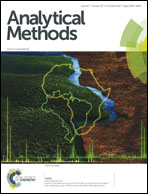Wood chemotaxonomy via ESI-MS profiles of phytochemical markers: the challenging case of African versus Brazilian mahogany woods
Abstract
The harvesting of Brazilian mahogany (Swietenia macrophylla) is a main cause of the Brazilian Amazon deforestation and has been therefore prohibited. African mahogany (Khaya ivorensis) was then introduced for Amazon reforestation and the commercialization of such wood is legal, thus creating a challenging problem for wood certification. Herein we report that a wood chemotaxonomic method based on distinct profiles of phytochemical markers is able to promptly characterize both the native and foreign mahogany species. This challenging task has been performed via a simple, fast and unambiguous methodology using direct electrospray ionization mass spectrometry (ESI-MS) analysis of a simple methanolic extract of a tiny wood chip. Typical limonoids such as khivorin, khayanolide A and mexicanolide for African mahogany and phragmalin-type limonoids for the native Brazilian species, as well as distinct polyphenols such as catechin derivatives and cinchonain, form the characteristic phytochemical marker pools for both species. This rapid methodology could therefore be used to monitor legal and illegal mahogany tree harvesting, and hence to control Amazon deforestation. It could also be applied to create a wood certification program for African and Brazilian mahogany trees, as well as for wood certification in general.


 Please wait while we load your content...
Please wait while we load your content...